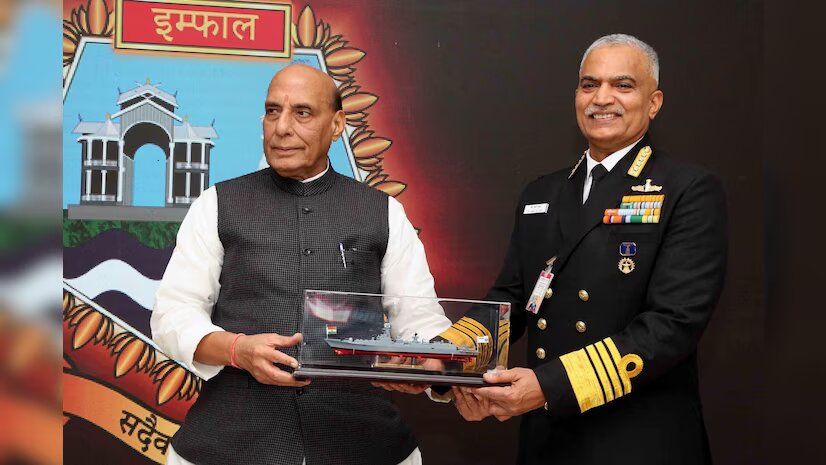Rajnath Singh Unveils Crest Of India’s Guided Missile Destroyer, Imphal

- The Indian Navy has named many of its ships after well-known cities, mountain ranges, rivers, ponds, and islands. This is a maritime tradition and naval custom.
- The Indian Navy is immensely proud of naming its latest and technologically most advanced warship after the historic city of Imphal
The Indian Navy’s stealth guided missile destroyer Imphal was given its crest on Tuesday by Defense Minister Rajnath Singh. The Imphal is equipped with BrahMos surface-to-surface missiles and indigenous rocket launchers for defense against submarines. Mazagon Dock Shipbuilders Limited (MDL), Mumbai, gave the ship to the Indian Navy on October 20.
Manipur’s Chief Minister N Biren Singh, India’s Chief of Defense Staff Gen. Anil Chauhan, and India’s Navy Chief Admiral R Hari Kumar all attended the ceremony in Delhi to unveil the crest.
As the third of the four Project 15B stealth guided missile destroyers, INS Imphal is complete.
The Kangla Palace is on the left side of the crest, and “Kangla-Sa” is on the right.
Putting up Imphal’s crest with the Kangla Palace and Kangla-Sa is a fitting tribute to what the people of Manipur have done for India’s independence, sovereignty, and security, according to the defense ministry.
In Manipur, the Kangla Palace is an important historical and archaeological site. It was also the seat of the kingdom in the past.
‘Kangla-Sa,’ a mythical character from Manipur’s history, has the head of a dragon and the body of a lion. It stands for the protector of the people of Manipur.
“Kangla-Sa” is also the symbol of Manipur as a state.
With a range of 164 meters and a weight of 7,400 tonnes, the guided missile destroyer Imphal is a strong and flexible platform that comes with cutting-edge sensors and weapons, such as surface-to-air missiles, anti-ship missiles, and torpedoes.
Through Combined Gas and Gas (COGAG) propulsion, the ship can reach speeds of over 30 knots (56 km/h).
The ship is made mostly of Indian parts, about 75% of it. It has BrahMos surface-to-surface missiles, medium range surface-to-air missiles, anti-submarine rocket launchers made in India, and a 76mm super rapid gun mount.
“Designed by the Indian Navy’s Warship Design Bureau and built by Mazagon Dock Shipbuilders Limited, Imphal is a hallmark of indigenous shipbuilding and is amongst the most technologically advanced warships in the world,” a statement from the ministry said.
The foundations for Imphal were laid on May 19, 2017, and the ship was put into service on April 20, 2019.
The ship left for its first sea trials on April 28. Since then, it has been through a full schedule of trials in port and at sea, and it will be delivered on October 20.
As part of its pre-commissioning tests, the ship recently fired an extended-range BrahMos missile successfully.
„Imphal was built and tested in the least amount of time of any indigenous destroyer. “The ship’s delivery is proof of the push toward ‘Aatmanirbhar Bharat,'” the ministry said.
The Indian Navy has named many of its ships after well-known cities, mountain ranges, rivers, ponds, and islands. This is a maritime tradition and naval custom.
“The Indian Navy is immensely proud of naming its latest and technologically most advanced warship after the historic city of Imphal,” a spokesperson from the Indian Navy said.
“This is the first capital warship to be named after a city in the North-Eastern region, the approval for which was accorded by the President on April 16, 2019,” he explained.







Facebook Comments